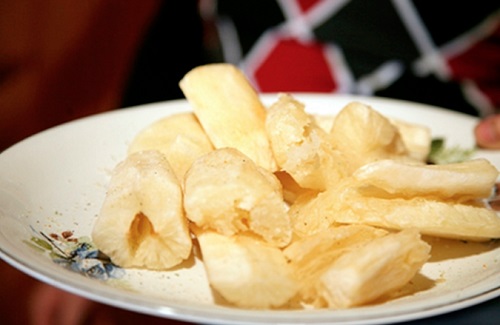
Bankye ampesi reduces risk of colon cancer
During my court attachment at the Cape Coast High Court, I noticed bankye ampesi was sold at some places close to the court. In the Gambia as well, cassava is part of their daily diet.
Advertisement
A recent study by Abdullah et al, (2022) found that cassava root is mainly high in vitamin C, an important vitamin that acts as an antioxidant, supports collagen production and enhances immunity, among other benefits.
The National Health Institute (2021) also found that cassava was rich in copper, a mineral necessary for neurotransmitter synthesis, energy production, iron metabolism and more.
Nutritional Profile
Hussein et al., (2012) study found that Cassava contained the following: Protein (0.35-2.45 %), ash (0.15-1.50%), fat (0.12-0.61%), fibre (0.01- 0.20%), carbohydrate (81.81-90.37%) and dry matter (81.792.69%).
The online site: https://fdc.nal.usda.gov/(2020), states that a 3.5-ounce (100-gram) serving of cooked cassava root contains 191 calories. This means that 84 per cent comes from carbs, while the rest comes from protein and fat.
Additionally, one serving also provides some fibre and a few vitamins and minerals.
Resistant starch
The Healthy Home Economist (2016) also calls cassava-resistant starch “the healthiest starch for your gut:” What does this mean to our health? They had this to say:
“Resistant starch is a type of starch that does not break down (it literally “resists” digestion), instead of being absorbed as glucose like most starches. Instead, resistant starch travels through the small intestine to the colon where it is turned into beneficial, energy-boosting, inflammation-squashing and short-chain fatty acids by intestinal bacteria.”
The main reason why resistant starch is so beneficial is that it feeds the friendly bacteria in your colon, turns them into important short-chain fatty acids, such as butyrate (known to help reduce inflammation), and is extremely helpful in cases of autoimmunity, IBS, colitis and allergies.
The Authority Nutrition (2016) also explains, “Most of the carbohydrates in the cassava diet are starches. Starches are long chains of glucose that are found in grains, potatoes, and various foods. But not all of the starch we eat gets digested. Sometimes a small part of it passes through the digestive tract unchanged. In other words, it is resistant to digestion.”
A study by Marandola et al., (2004) found that cassava may also, by a different mechanism, be protective against cancer because it contains a chemical called tamarin, which is responsible for the production of hydrocyanide.
This tamarin has been shown in vitro to cause the death of cancer cells by self-toxicity with hydrocyanide.
Another study by Tsumbu et al., (2011) found that cassava leaves, roots show promise against colon cancer. Irabor (2011) found that the low colon cancer in Nigeria could be due to the consumption of resistant starch foods.
Promotes wound healing
According to fdc.nal.usda.gov, cassava is loaded with vitamin C, with 20 per cent of the Daily Value in each 3.5-ounce (100-gram) serving.
Other studies found that cassava provided about 50 per cent of the daily vitamin C needs for most adults.
Vitamin C plays a key role in many aspects of health, including immunity. Carr and Maggini (2017) study found that vitamin C can help protect against oxidative stress and support the function of immune cells in your body.
Another interesting thing is that the nutritional profile of cassava can be affected by processing, such as peeling, chopping and cooking.
However, a study by Julie et al., (2009) found that though cooking affected the nutritional content, cooking cassava before consumption was important to avoid side effects.
Julie et al., (2009) additionally found that boiling cassava root still retained more nutrients, compared with other cooking methods such as roasting or frying. The exception is vitamin C, which is sensitive to heat and easily leaches into the water.
This means that our traditional processing forms of cassava such as tapioca, garri, and fufu are likely to reduce their nutritional value.
Additionally, cooking is still a less processed technique to provide nutritional value.
Take home
Though bankye ampesi is cooked, Julie et al., (2009) found that boiling cassava root still retains more nutrients, compared with other cooking methods like roasting or frying. Also, more studies support eating cassava to reduce our risk of colon cancer.
It is further enriched with high Potassium which reduces high blood pressure. Finally, assess your needs first and understand how your body responds to diet. There is no one-size-fits-all approach to diet.
The writer is Professor, Naturopathic Healthcare/President, Nyarkotey College of Holistic Medicine & Technology (NUCHMT)/African Naturopathic Foundation. He adheres to strict sourcing, studies and academic papers in his articles, which are for educational purposes only, and not medical advice for treatment.
E-mail: [email protected]




